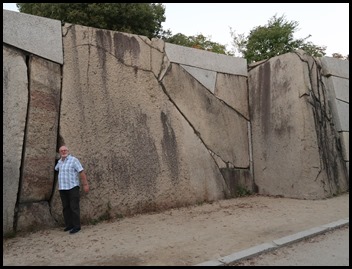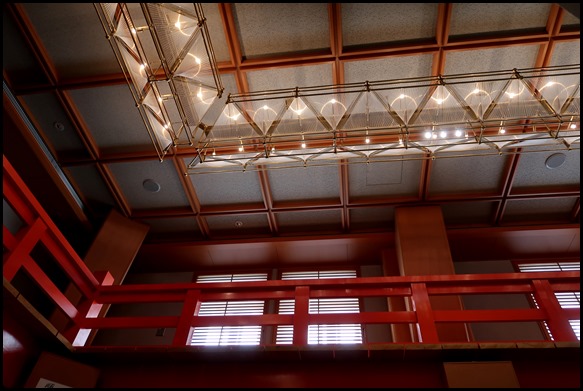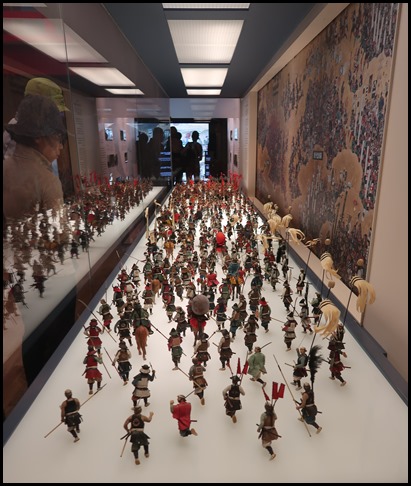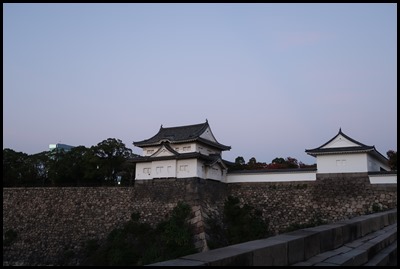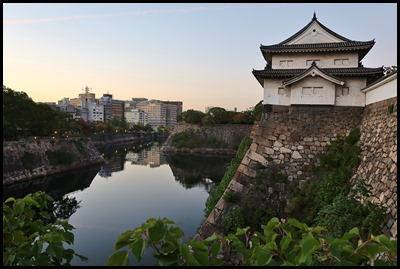Osaka Castle

|
Osaka
Castle
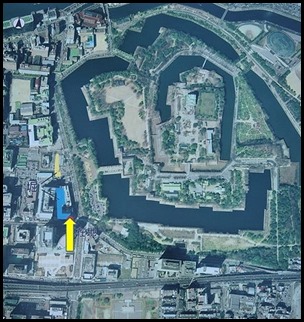  We bimbled from our digs to visit
Osaka Castle, the most popular tourist destination in the city. En route we saw
an information board and pictures (yellow arrows
added to help) - The Excavation of Osaka Castle of the Toyotomi Period at
Osaka Prefectural Police Headquarters site: Upon excavation in 2003 before the
construction of the building, we found a huge moat made in the period Toyotomi
Hideyoshi and his son ruled Japan at the end of the Middle
Ages.
The main entrance of the castle
was surrounded by this moat. The bottom of the moat was dug uneven i the way
which ground plan seemed like a lattice, presumed to be the defense against
enemy’s invasion.
Through the observation of soil
strata, we concluded that this moat had been buried soon after the Battle of
Osaka Winter Campaign in 1614. A wooden label with the name “Kan Heiemon”
unearthed from the soil supported this point of view. The same name was found in
the contemporary document which showed us that he joined the Battle at
adversarial relationship against the Toyotomis, and committed Hara-kiri suicide
in the end of 1614.
This excavation proved the burial
work of the moat was a crash job done by Tokugawa Ieyasu. It also gave us
abundant information about the Osaka Castle of the Toyotomis. Fascinating.
We were still over the other side of a main road and were a long way from the
castle entrance at this point, so it must have been a massive area in its
day.
 We crossed the main road and looked
back at the Police Headquarters, which, in itself was
no small building. (Footprint above right).
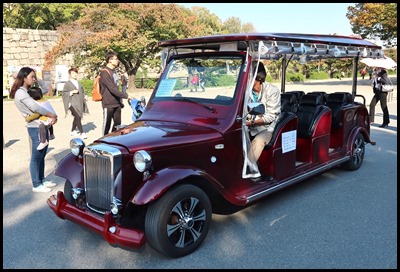 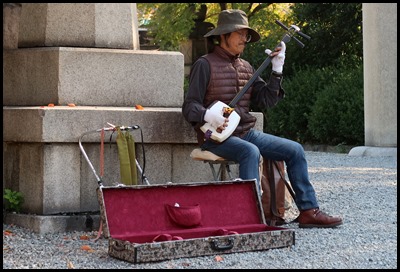 At the corner of the park we jumped
aboard this stately looking buggy, complete with
ice-cream-van-type-music. Bear handed over fifty pence for himself as an OAP and
paid my seventy five pence. We trundled along the path, crossed the current moat
and it dropped us by the main entrance. ‘Keef’ was giving it stacks on a traditional guitar so
we bought an ice cream and sat to listen for a while.
 A gatehouse
we could see in a corner of the moat. A secret passage was built here under the
moat.
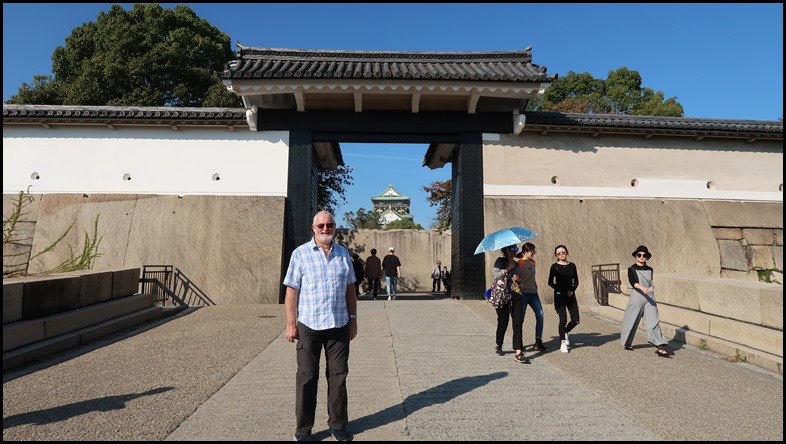 Bear standing in front of the Sakuramon Gate, the castle some way off behind
him.
This is the main gate of the
Hommaru (Inner Baily) of Osaka Castle. Built during the early Edo
period in 1626, this gate was lost in fire during the Meiji Restoration in 1868
and reconstructed by the army in 1887. The name Sakuramon, or cherry gate, is
considered to come from a line of cherry trees planted near this gate during the
Toyotomi Period (late 16th century), which preceded the Edo Period (1603-1867).
The huge stones on both sides of the gate are known as Ryukoishi, which means
dragon and tiger stones. Legend says that when it rained, an image of a dragon
and that of a tiger appeared on the stones on the right and left
respectively.
  Quite a
hinge and an amazing bit of wood
splicing.
  The Well Curb of the Gimmeisui Well: This well curb was originally used for
the Gimmeisui Well, located at the back of the headquarter building of the
former Army Fourth Division, in the Hommaru (Inner Baily). During the Edo Period
(1603-1867), the Gimmeisui Well was located behind the Hommaru palace kitchen
and used as a source of drinking water by officials. When the headquarter
building of the Fourth Division was constructed in 1931, the well curb and the
cobbles around the well were brought to the present site and running water was
piped to the new building to provide drinking water.
Bear dwarfed by the Octopus Stone, the largest at the castle and the Ote Mitsuke Stone.
The Octopus Stone stands at the far end of the courtyard from Sakuramon Gate, the main entrance to the inner bailey. During the repair of the Kyobashi-guchi courtyard (completed in March 1978), it was discovered that the Higo Stone and other adjacent stones, are in fact, quite thin, and are supported from behind. As a result of an investigation into a gap that was found at its right end, it was found that the Octopus Stone, too is quite thin with a thickness of 70 to 90 centimetres. The thickness of the huge stones that were used, were probably chosen because of the technical difficulty to cut and transport such large stones, but the builders wanted to have as much surface as possible. Almost all the stones that make up the walls of Osaka Castle have a depth of two or three times their width or height. These huge stones, however, are exceptions.
To our right as we entered the huge grounds was a fancy building, Miraiza (restaurants and bars) and the castle in front of us.
The construction of Osaka Castle began in 1583 on the site of Ishiyama Honganji Temple, which had been destroyed thirteen years earlier. Toyotomi Hideyoshi intended the castle to become the centre of a new, unified Japan under Toyotomi rule. It was the largest castle at the time. However, a few years after Hideyoshi's death, Tokugawa troops attacked and destroyed the castle and terminated the Toyotomi lineage in 1615. Osaka Castle was rebuilt by Tokugawa Hidetada in the 1620’s, but its main castle tower was struck by lightning in 1665 and burnt down. In 1931 the present concrete castle tower was built and miraculously survived the city-wide air raids during WWII. Major repair works gave the castle a face lift in 1997. The castle tower is now entirely modern and a lift took us to the top.
A Signal Gun or Noon Marker:
This is an ancient, muzzle-loading cannon, of 348 cm or 137 inches in its
overall length, and 40 cm or 15.7 inches in the outer diameter and 20 cm or 7.85
inches in its bore, with base material probably made of a sort of
bronze.
Manufactured in 1863, at the Tokugawa
government’s order, by Seijiro Kudara of the Tsuyama-han, Mimasaka (the
present-day Tsuyama city, Okayama prefecture), it had been installed at Osaka’s
Tempozan battery until the Meiji Restoration, after which it had been
transferred to the Osaka Castle
grounds.
Beginning with the Meiji 3rd (1970) it had seen its use as a time-signalling gun, at first fired thrice a day until the Meiji 7th (1874) in and after the year it had been employed as the noon marker, thus coming to be familiarized with the citizenry as the Castle’s don (Bang!), or its Noontime don throughout the city. To save gun powder and for other reasons, its use seems to have been terminated, sometime during the Taisho 12 or 13 (1923 or 1924) its exact date and reasons are not clear.
We entered the castle, took the lift to the top with the idea to work our way down. Looking out to the west over the Nishi-no-manu Castle Garden.
Looking north and south (the way we had come in).
Looking east over the Japanese Apricot Gardens toward Mount Ikoma. The red and white striped pole stands just behind JR Osaka-jo Koen Station.
We could photograph some of the museum over three floors but not all. Lovely, fresh decor.
We enjoyed the model of the Summer War of Osaka.
The Summer War of Osaka, a number of banners of the generals are depicted, including a variety of standards which were used to mark individual corps, as well as armour ornaments, which were carried on the backs of warriors. In addition, there were horse standards, used to mark the position of the generals who fought in the war. It is possible to identify 25 banners of the Tokugawa forces and 13 banners of the Toyotomi forces. The banners shown in the folding screen illustrating the Summer War are reproduced in this picture, although there are differences in design between banners depicted in the “Picture of Generals’ Banners and Standards”, and the family crests that have been identified by tombstones.
Sites of Minami-shikirimon Gate and Taiko-yagura Turret: The western and southern sections in the Ni-no-maru (Outer Baily) were divided by two stone walls, and access between the divided sections was provided by a gate called the Minami-shikirimon, literally, a south-dividing gate. On the stone wall to the west of this gate, stood a turret called Taiko-yagura Turret, or drum turret. Both of these structures are considered to have been built in 1628, during the early Edo period. The Taiko-yagura Turret housed a drum, which was beaten to summon samurai working in the castle, signal the change of shift, and alert people of emergencies. Both structures were lost in fire during the Meiji Restoration in 1868.
We very much enjoyed the walk from the castle through the grounds just before dusk.
Bear dwarfed by the exit gate.
Huge Stones at Ote-guchi-masugata Square: Masugata is a square set adjacent to the main gate of a Japanese castle and served to prevent the intrusion of enemies. Ote-guchi-masugata, one of he Masugata Squares in Osaka Castle, incorporated many huge stones. For example, the stone placed at the front behind the Otemon Gate measures 47.98 square metres in surface area, which is the fourth largest in the Osaka Castle. The stone walls of the castle that remain today were built as part of Osaka Castle reconstruction work initiated by the Tokugawa shogunate in 1620. This part of the stone walls was reconstructed by Tadahiro Kato, a feudal lord of the Kumamote and later renovated by Toyouji Arima, a feudal lord of the Kurume.
We gave a look back to buildings used for ‘escorts’ and crossed the moat at the far corner to where we had entered.
ALL IN ALL A PRETTY BUILDING A VERY AUTHENTIC LOOKING REPLICA |

